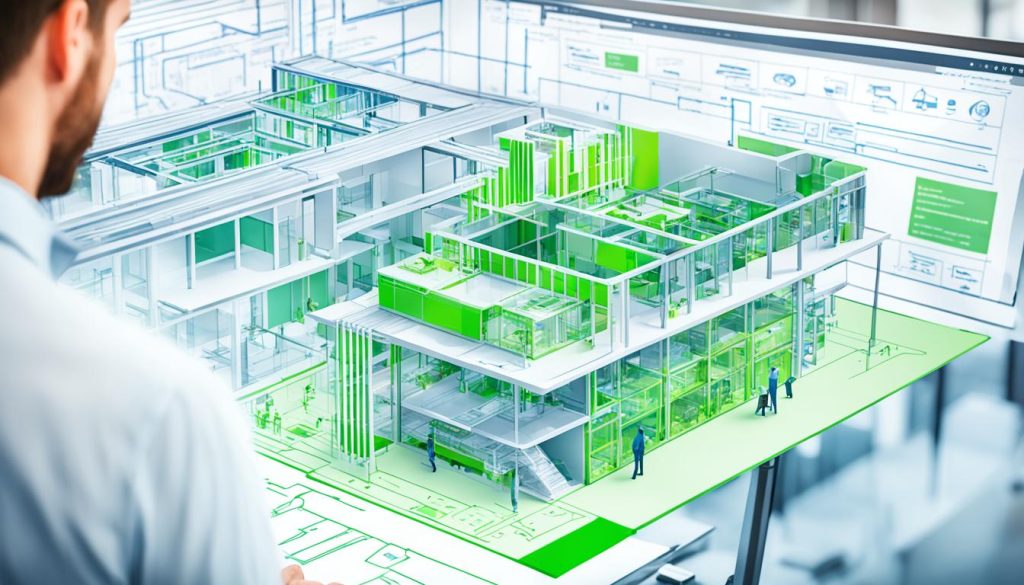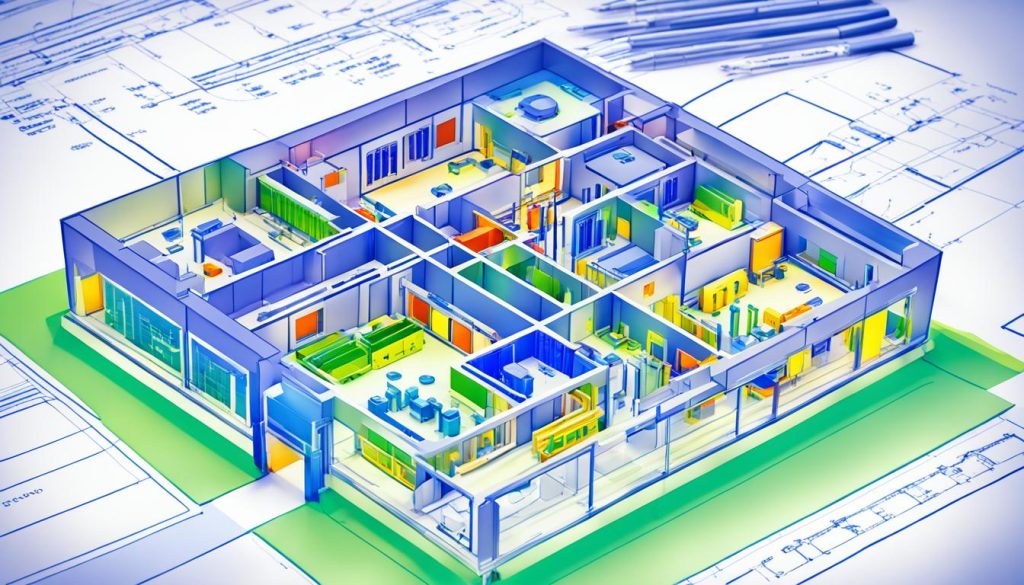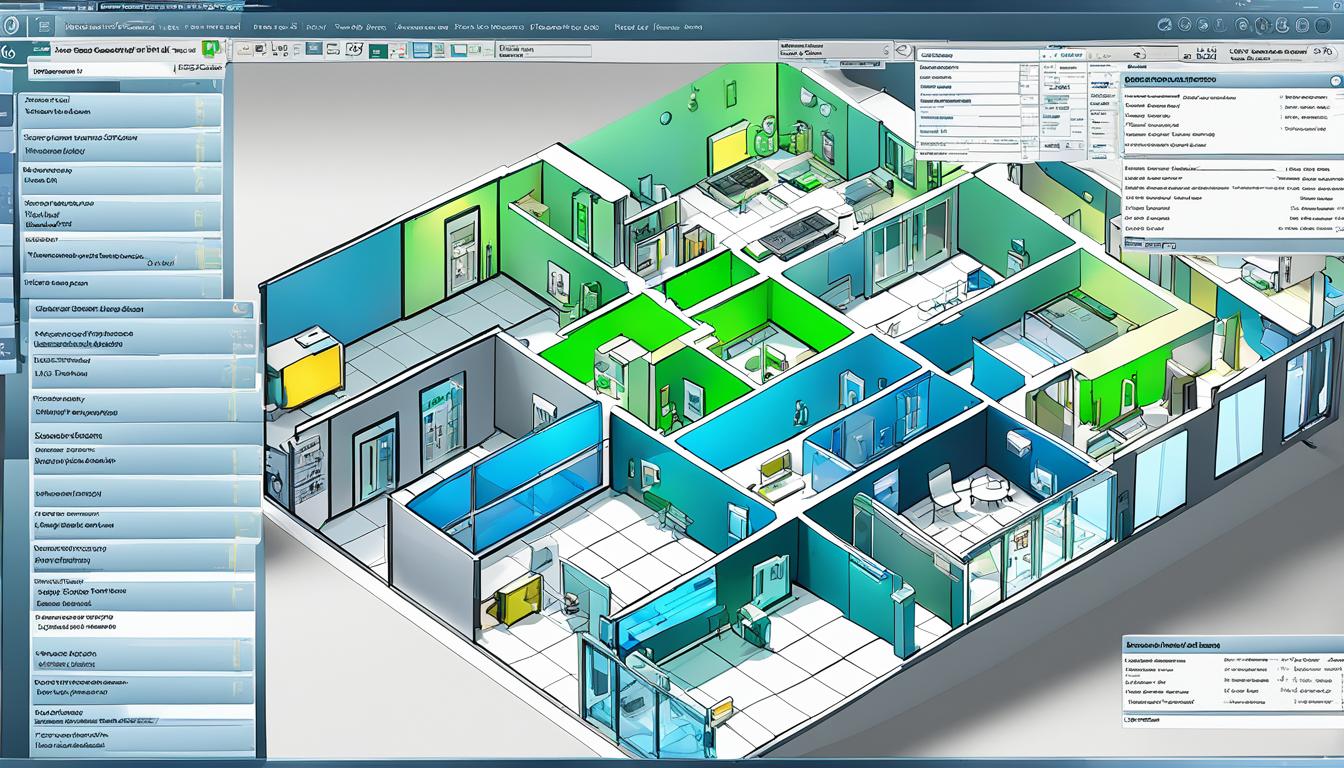You can use CAD HVAC software for precise load calculations and energy efficiency analysis. This tool combines advanced features to make your work easier and more accurate. It helps in building energy modeling.
This software brings together load calculations, system design, and energy analysis in one place. It makes the design process simpler, from the start to the end. It includes smart objects that keep track of information and update components automatically when needed.
It supports both 2D and 3D designs, letting you see buildings with detailed 3D duct layouts. This approach helps you improve energy efficiency and get accurate load calculations for your projects.
Introduction to CAD HVAC Software
CAD HVAC software changes how we design HVAC systems for buildings. It makes the design process more precise and efficient. This tool helps with load estimation and energy analysis.
What is CAD HVAC Software?
CAD HVAC software is a special tool for designing heating, ventilation, and air conditioning systems. It lets engineers and designers make detailed 3D models. These models include complex calculations and simulations for the best performance.
Benefits of Using CAD HVAC Software
The benefits of CAD HVAC software are many:
- Increased accuracy in load estimation
- Streamlined workflow for faster project completion
- Enhanced energy analysis capabilities
- Reduced errors and rework
- Improved collaboration among project teams
Key Features of Modern CAD HVAC Solutions
Today’s CAD HVAC software has many advanced features:
| Feature | Description | Impact on Design |
|---|---|---|
| 3D Modeling | Create detailed spatial representations | Improves visualization and clash detection |
| Automatic Calculations | Performs complex load and energy computations | Enhances accuracy and saves time |
| BIM Integration | Connects with Building Information Modeling | Facilitates holistic building design |
| Customizable Libraries | Includes extensive equipment databases | Enables precise component selection |
| Reporting Tools | Generates comprehensive project documentation | Streamlines approval and compliance processes |
With these features, HVAC professionals can handle complex designs with more confidence and efficiency.
Understanding Load Calculations in HVAC Design
Load calculations are key to good HVAC design. They figure out how much heating and cooling a building needs. This ensures the space is comfortable and uses less energy. For sustainable design, getting these calculations right is vital to cut energy use and keep the indoor climate perfect.
Designers look at building size, insulation, how many people will be there, and the local weather. They also count up the number of fixtures, furniture, and equipment. Today, they use energy simulation tools to make these calculations more precise and predict how the system will work under different conditions.
Building Information Modeling (BIM) has changed how we do load calculations. BIM makes gathering data easier by giving HVAC designers what they need. This means faster and more precise calculations, less time on manual work, and fewer mistakes.
| Load Calculation Factor | Impact on HVAC Design | BIM Integration Benefit |
|---|---|---|
| Building Envelope | Determines heat gain/loss | Automatic material properties |
| Occupancy | Affects internal heat loads | Space usage data readily available |
| Equipment | Contributes to cooling load | Accurate equipment schedules |
| Lighting | Impacts cooling requirements | Integrated lighting design data |
Using BIM and energy simulation tools helps designers make HVAC systems better and greener. This method is more accurate and meets the need for energy-saving buildings in the U.S.
Use CAD HVAC Software for Load Calculations and Energy Efficiency Analysis
CAD HVAC software changes how you handle load calculations and energy efficiency for commercial buildings. These tools make the process easier, giving you precise results and the best system design.
Step-by-Step Guide to Performing Load Calculations
Begin by adding building details to your CAD HVAC software. This includes size, materials, and how the building faces. The software uses smart algorithms to figure out heating and cooling needs, following ASHRAE standards. It also considers things like shadows and how air moves in and out for accurate load estimates.
Integrating Energy Efficiency Analysis into Your Workflow
Today’s CAD HVAC software does more than just load calculations. It helps you do a deep energy analysis to design efficient HVAC systems. With built-in tools, you can improve system performance and meet energy codes.
Tips for Maximizing Accuracy and Efficiency
- Use built-in weather data for accurate climate factors
- Consider building rotation to get the right solar effect
- Enter detailed load profiles for each area
- Use automatic duct sizing for the best airflow
- Compare different scenarios to see energy use
By following these steps and tips, you’ll get the most out of CAD HVAC software. This method ensures you get accurate load calculations and energy analysis. It leads to more efficient HVAC designs for commercial buildings.
Building Information Modeling (BIM) Integration
BIM integration changes how we design HVAC systems by making a digital copy of buildings. It uses spatial elements that grow to fit spaces, helping us figure out thermal needs and loads.

In BIM-integrated HVAC design, virtual objects grow until they hit walls, roofs, or windows. This lets us automatically calculate areas and thermal properties. BIM also keeps track of things like lights and furniture, giving us important data for load calculations.
The benefits of combining BIM with HVAC design are many:
- Automatic comparison of assumed plug loads with electrical engineer assumptions
- Direct use of BIM data in built-in load calculation engines
- Export of data as Green Building XML (gbXML) files for use in third-party software
- Enhanced collaboration between architects, engineers, and contractors
- Improved accuracy in energy simulation and sustainable design practices
Using BIM integration makes designing HVAC systems faster and more accurate. It saves time and boosts the efficiency and sustainability of your projects.
| BIM Integration Feature | Benefit for HVAC Design |
|---|---|
| Spatial element modeling | Accurate area and thermal property calculations |
| Internal component tracking | Precise internal load calculations |
| Automatic load comparison | Improved coordination with electrical systems |
| gbXML export capability | Compatibility with third-party energy simulation tools |
Advanced Features for Precise HVAC Design
Modern CAD HVAC software has cutting-edge features that change the game in design. These tools make designs more accurate, streamline the process, and boost project efficiency.
3D Modeling and Visualization
3D HVAC design changes how engineers think about and show their projects. With top-notch visualization tools, you can see designs in 2D, 3D wireframe, and realistic 3D. This makes it easier to understand the layout and talk to clients and stakeholders.
Automatic Duct and Piping Layout
Make designing easier with automatic duct and piping layout tools. These smart tools create efficient paths for air and fluid flow. Auto-branch run and auto-size registers cut down on time and mistakes in sizing. Riser take-off lets you design with more flexibility.
Clash Detection and Resolution
Clash detection is a big deal in HVAC design. It finds conflicts between different systems early on. This way, you can fix issues before building starts, saving time and money. The software points out clashes and offers solutions, making sure HVAC fits well with other building parts.
| Feature | Benefit | Impact on Design Process |
|---|---|---|
| 3D Modeling | Enhanced visualization | Improved spatial understanding |
| Automatic Layout | Time-saving | Faster design iterations |
| Clash Detection | Error reduction | Smoother construction phase |
Using these advanced features, you can make HVAC designs more precise, efficient, and free of conflicts. The mix of 3D modeling, automated layouts, and clash detection tools lets you confidently deliver top-notch projects.
Energy Simulation and Analysis Tools
Energy simulation and building energy modeling are key in modern HVAC design. They help make HVAC systems more energy-efficient and support sustainable design. With advanced software, you can deeply analyze how systems perform and use energy.
CAD HVAC software works well with energy modeling tools like EnergyPlus. This lets you create energy models easily for a full lifecycle analysis of your HVAC systems. You can also move data from programs like Chvac to tools like Elite Software’s Energy Audit and eQUEST.
These tools let you look at variable loads, how equipment performs, schedules, and control schemes. You can see how heat recovery ventilators (HRV) help with heating and cooling. Energy simulation software gives you detailed psychrometric data. This helps you make your HVAC designs as efficient as possible.
| Feature | Benefit |
|---|---|
| Variable Load Analysis | Optimizes system sizing for different conditions |
| Equipment Performance Simulation | Helps select the most efficient components |
| Operating Schedule Optimization | Reduces energy waste during off-peak hours |
| Control Scheme Evaluation | Improves system responsiveness and efficiency |
| HRV Benefit Calculation | Quantifies energy savings from heat recovery |
Using these energy simulation and analysis tools, you can design HVAC systems that go beyond energy efficiency standards. This leads to more sustainable buildings and lower costs over time.
Case Studies: Successful Implementation of CAD HVAC Software
CAD HVAC software has changed the game for professionals in HVAC design and implementation. Let’s dive into some real-world examples that show how the software has made a big impact. These examples cover commercial HVAC, residential HVAC, and building retrofits.
Commercial Building Project
In a recent project on an office complex, CAD HVAC software was a game-changer. It quickly figured out the loads for many air handling systems. It took into account things like pre-treated outside air and systems that change air volume. This led to a 15% drop in energy use compared to old design methods.
Residential HVAC System Design
A custom home had a tricky layout that posed challenges. But the CAD HVAC software made quick work of it. It managed seasonal changes in air flow and ventilation rates. The end result was a system that kept the home comfortable all year and used less energy.
Retrofit and Renovation Challenges
Building retrofits can be tough. In one instance, CAD HVAC software was key to solving an old warehouse conversion. It could import building data and run different “What If?” scenarios. This led to a solution that kept the building’s original look while meeting today’s energy standards.
| Project Type | Key Benefit | Energy Savings |
|---|---|---|
| Commercial Office | Multi-system load calculation | 15% |
| Custom Residential | Seasonal variation handling | 20% |
| Warehouse Retrofit | Scenario analysis | 25% |
These examples show how CAD HVAC software is versatile and powerful. It works well on different projects, from big commercial HVAC jobs to smaller residential systems and complex retrofits.
Best Practices for CAD HVAC Software Adoption
Adopting CAD HVAC software can change how you design, but it needs careful planning. Start with thorough training and set up standard workflows. This ensures your team uses the software’s full power for designing energy-efficient and sustainable HVAC systems.

First, create a detailed training program. Teach everything from the basics to advanced features. Investing in your team’s skills boosts efficiency and accuracy in HVAC design projects.
Next, set up standard workflows to make your design process smoother. These rules keep projects and team members consistent. They also make it easier for the architectural, electrical, and mechanical teams to work together. This is key for getting the most out of BIM integration.
- Regularly update material libraries and weather data
- Validate BIM data before use
- Establish protocols for overriding incorrect data
- Implement a system for regular software updates
- Stay informed about new features and capabilities
By following these best practices, you’ll be ready to fully use CAD HVAC software. This approach not only betters your design process. It also boosts your ability to create energy-efficient and sustainable HVAC systems for modern buildings.
Conclusion
CAD HVAC software has changed how we design and analyze HVAC systems. It brings together load calculations, system design, and energy efficiency in one place. This makes the whole process smoother.
Now, tasks like material takeoffs and data entry are quicker and more precise. The software links with Building Information Modeling (BIM) data for better HVAC designs. This means your systems work better and use less energy.
With stricter energy efficiency standards, CAD HVAC software is more important than ever. It lets you simulate energy use and test different designs. Using these tools helps you make HVAC systems that are sustainable and meet high standards.





0 Comments